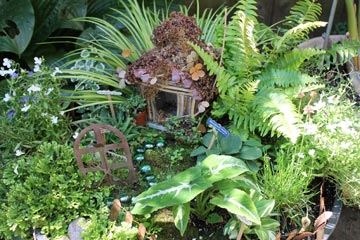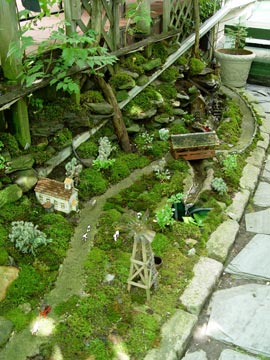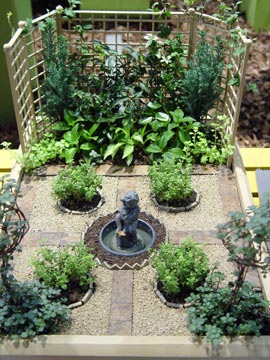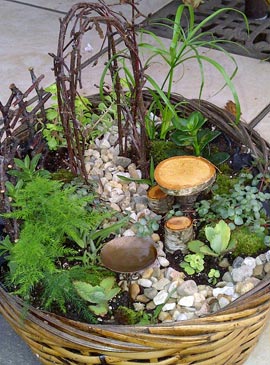 This fairy garden is an outdoor, in-ground model that uses a traditional woodland theme.
This fairy garden is an outdoor, in-ground model that uses a traditional woodland theme.
© George Weigel
Maybe it’s the childlike nature coming out in “maturing” gardeners, but whatever the reason, fairy gardens have become one of gardening’s hottest trends lately. Fairy gardens are miniature gardens constructed of diminutive plants and tiny accessories designed to lure fairies. They can be outside gardens with in-ground plants, or they can be mini container gardens intended mainly for indoors – at least part of the time.
In Celtic lore, fairies are worth attracting because if you’re nice to them, they’ll bring you good luck, health and prosperity. That raises the question of just how a gardener goes about attracting fairies. The secret seems to be giving them a welcoming, peaceful setting, complete with a little house and ample places to play and sit. Exactly what form that takes is a big part of the pleasure of this kind of gardening. Every fairy garden is highly personalized as the creator gets to pick whatever kind of setting catches their fancy.
 A working train runs through this miniature village that uses moss to simulate grassy fields.
A working train runs through this miniature village that uses moss to simulate grassy fields.
© George Weigel
Gardeners who lean to cottage gardens can opt for a Victorian house surrounded by a floral potpourri, such as miniature roses, sweet alyssum and perennial pinks. Traditionalists might figure a woodland setting will be more to a typical fairy’s liking, and so they might go with a mini log cabin surrounded with green moss, miniature ivies and dwarf boxwoods snipped into what look like little trees. Or formal-leaning gardeners might shoot to attract fairy royalty by recreating something akin to the Chateau de Villandry or the Governor’s Palace at Williamsburg. In other words, rules are few when it comes to designing a fairy garden. Imagination is king.
The growing popularity of fairy gardening has spawned a growing industry in accessories. Numerous catalogs offer everything from the tiniest ornaments to fairy houses to entire fairy gardens, and most garden centers are quickly following suit. Part of the fun also is being creative in scavenging and crafting one’s own fairy-garden components. Bark from a landscape tree, for example, makes ideal walls for a fairy cottage. Acorns become barrels, twigs can be fashioned into arbors, and broken, second-hand dish pieces make superb fairy garden paths.
 This table-top miniature garden in a box takes a formal turn—complete with a statue in the middle.
This table-top miniature garden in a box takes a formal turn—complete with a statue in the middle.
© George Weigel
Outdoor fairy gardens are often located around trees, under bushes, next to stumps and in similar shady, partially hidden spots. After all, fairies aren’t any more comfortable out in the blaring sun in the middle of the yard than you are. Container fairy gardens can be indoor or outdoor models. Outdoor ones can be planted in boxes mounted on legs, in window boxes, in pots, in half whiskey barrels or in unexpected vessels, such as a birdbath, an antique washtub or a rusty wheelbarrow. Smaller containers, such as bowls, old drawers and jewelry boxes, are portable enough to move in and out – or they can be inside-only. What really makes a fairy garden a garden, though, is the plants.
Dwarf and miniature plants are the best choices in fairy gardens. The idea is to make the plants look like they’re in scale with the accessories and the fairy garden as a whole. Two places to look first when plant-shopping for a fairy garden – the groundcover and herb sections. Most groundcovers are low-growing and small-leafed – perfect for mini gardens. These include choices such as creeping sedum, dwarf mondo grass, baby tears, ajuga, blue star creeper, creeping fig, miniature ivies and assorted mosses.
 This fairy garden uses twigs for an arbor and is built in a wicker basket.
This fairy garden uses twigs for an arbor and is built in a wicker basket.
© Susan Weigel
In the herb section, you’ll find such ideal fairy choices as woolly and ‘Elfin’ thymes, golden oregano, small-leafed basil and lavender and rosemary – both of which look a lot like mini evergreens when snipped just so. You’ll also find good choices among tropicals and houseplants, especially demure succulents, such as sempervivums (“hens and chicks”), dwarf aloe, kalanchoe, echeverias and even young, slow-growing palms. Dwarf conifers and dwarf boxwoods are two good species to check out in the nursery section.
Just as in any garden, pick plants that are suited for the intended site. Think shade-preferring species for your woodland fairy garden and species that can handle low light and dry air in your indoor fairy garden. You’ll also need to do a fair amount of snipping to keep your fairy plants at a fairy size. It’s much like bonsai, which in a way, is a cousin gardening style to fairy gardening.
Fairy-garden plants – particularly those in containers – will need small amounts of water on a frequent basis. And just like any plant, they’ll also need fertilizer. If any plants get so big and woody that they’re outgrowing the garden’s scale despite snipping, plant them in a “real” garden and replace them with a young and tiny substitute. Or chip the too-big plant and add it to your fairy-garden compost bin.
Don’t be surprised if you find your fairy garden in disarray some morning. Those all-night fairy parties can get a little crazy…